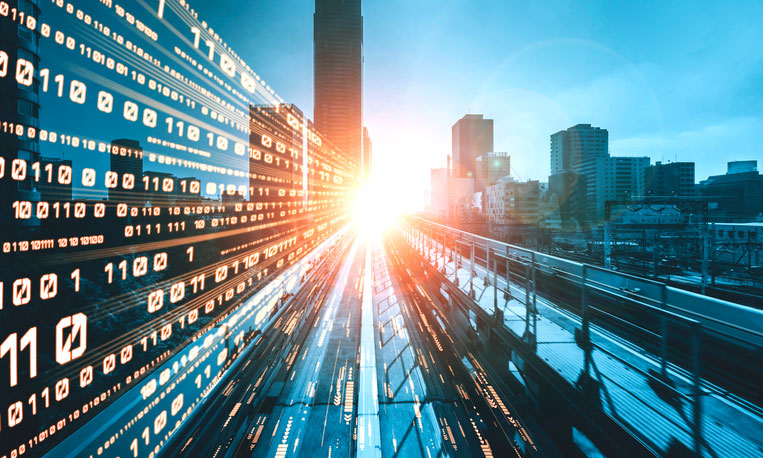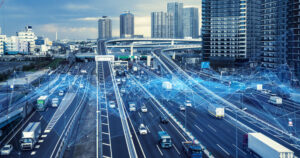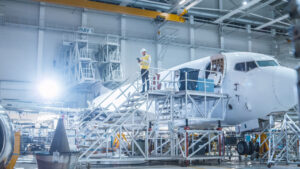Written by Scott Wilson

Smart cars, drones, automated delivery vehicles… these are what pop into your head when someone mentions AI and transportation in the same sentence.
All those technologies will create a big impact on how people and goods get around in the future. But that impact may not be what you imagine—unless transportation systems design keeps up with the new capabilities.
Transportation systems are all around us, all the time. Planes fly through an invisible web of patterns overhead; cars line roads, highways, and byways; freight moves by barge and by rail in every part of the nation. Even oil, the lifeblood of every other form of locomotion, courses through pipelines and in tankers that have to adjust to demand each day.
Transportation system design and operation in all those various areas will be crucial to getting the full benefits of all those advances. Planners and managers will be using artificial intelligence to make all that happen.



What Is Transportation System Design and Management?
Most people are vaguely aware that there are people sitting around in offices at state, local, and federal transportation agencies who are responsible for all the nuts and bolts that go into their daily commute:
- The design and layout of road, rail, marine, and air corridors
- Flow management of vehicles through the system
- Technology used for safety and tracking
- Requirements for basic equipment, construction techniques, and backups
- Rules and regulations that govern individuals and organizations using the systems
But few people understand how deep those responsibilities go. And most don’t realize how vital those systems are to our way of life.
According to the Bureau of Transportation Statistics, in 2022 the U.S. freight transportation systems moved almost 20 billion tons of goods worth around $19 trillion. That all trickled out through:
- More than 4 million freight trucks moving on 4 million miles of public roadway
- Over 3 million miles of pipeline carrying oil, gas, and other chemicals around the nation
- Massive freighters hopping ports around the seaboards and rivers, on average shifting their cargo in just over a single day at each stop
In 2023, the Department of Transportation reported that more than 40 percent of drone use in the United States was for commercial purposes.
Retailers, manufacturers, utilities, construction companies, and agriculture all depend on those modes. By itself, the industry represents 9 percent of total U.S. GDP. But much of the rest of that nearly $30 trillion each year depends on all those processes, too. None of them happen without a lot of planning and coordination.
Without big changes in how all those processes happen, the system won’t survive the one-two punch of climate change and AI being introduced into vehicles themselves.
How Artificial Intelligence Is Being Used in Transportation Systems
 Transportation systems designers have long relied on data science and the advances in machine learning that power it. Working with large numbers and great distances, the analytics that come from big data have been crucial in informing transport system design decisions.
Transportation systems designers have long relied on data science and the advances in machine learning that power it. Working with large numbers and great distances, the analytics that come from big data have been crucial in informing transport system design decisions.
Of course, as ML has become smarter and more sophisticated, those analytics have gotten better and faster. Recent studies have found certain machine learning traffic simulations are just as good at predicting flows and incidents as individually simulating each vehicle in the system.
Building on those analytics, one huge change AI will bring to designers is more sophisticated modeling. Computers are already heavily used to simulate potential changes in roads or air routes, bus line additions, and population and demand fluctuations. AI will bring a new level of accuracy and flexibility to those models. Generative systems will model predicted human agent behavior better than ever. And those algorithms may suggest non-intuitive changes to improve the system before it ever gets out of the design process.
Computer vision AI is already at work in traffic system management in sophisticated license plate readers that monitor toll routes and enforce parking regulations.
Finally, weather is one of the biggest factors in the smooth functioning of transportation systems of all kinds. So AI-driven improvements in meteorology and climatology will be big on both sides of the transportation system. Designers will benefit from better climatological models to build resilient roads, bridges, and ports. Managers will make use of better forecasts to make up-to-the-minute decisions about routing and flow control for safety and efficiency.
Why Transportation Professionals Will Need Expert AI Advisors Soon
 Perhaps the biggest game-changer for transportation system designers and managers, though, will simply be dealing with AI as it is deployed within the networks they build.
Perhaps the biggest game-changer for transportation system designers and managers, though, will simply be dealing with AI as it is deployed within the networks they build.
So one of the first things that AI experts will be needed for in transportation systems design is simply to act as advisors.
Transportation systems designers will need to react to AI being deployed by the vehicles within the transportation system. And that is already starting to happen.
Creating Transportation Systems That Aren’t Hostage to Autonomous Vehicles Is Job One
 It turns out that even relatively unsophisticated AI can have a big impact on transportation systems that weren’t designed for it. In New Jersey, ML-powered navigation apps found the little town of Leonia had magical properties for shortcuts for the hordes of commuters streaming in and out of next-door neighbor New York City each day. The resulting havoc within the town lead the police to close all streets to nonresidents during commuting hours each day.
It turns out that even relatively unsophisticated AI can have a big impact on transportation systems that weren’t designed for it. In New Jersey, ML-powered navigation apps found the little town of Leonia had magical properties for shortcuts for the hordes of commuters streaming in and out of next-door neighbor New York City each day. The resulting havoc within the town lead the police to close all streets to nonresidents during commuting hours each day.
Similar emergent behaviors will come to every part of the transportation sector. Whether it’s autonomous drones intruding into flight paths for commercial airliners, people instructing self-driving cars to circle the block endlessly rather than paying for parking, or kids tripping the safety stop features of robo-taxis for kicks, there will be a lot of unexpected consequences to deal with.
AI may be both the agent of such chaos and the solution. Transportation system designers will have to use more in-depth simulation and design to head off breakdowns and glitches resulting from the unexpected.
Entirely outside their control, breakthroughs in route-finding AI, autonomous vehicles, and safety systems will create new flow behavior that doesn’t resemble what humans do. They’ll need an understanding of ML-driven systems to account for those shifts in their own designs.
Just as high-speed trading algorithms have disrupted financial markets by creating conditions that human traders couldn’t, AI-driven routing and driving algorithms will create new problems transportation planners will have to address.
AI will deliver tools to cope with AI-driven problems, however. Particularly in the area of traffic flow analysis and incident detection, trained algorithms may spot problems emerging long before human analysts. With the ability to integrate diverse data and make sense of it, AI can watch a thousand camera feeds, absorb millions of sensor feeds from weather conditions to traffic counters, and even keep an eye on social media to correlate conditions that lead to problems.
What Jobs Will AI Professionals Fill in Transportation System Design?
 Although positions in transportation systems may not deal directly in the development of autonomous driving and piloting systems, they definitely need to be familiar with those technologies and their capabilities. So you will find job listings for positions like a UAV Swarm Specialist with AI expertise or AI Transportation Analyst that will help inform future designs and designers.
Although positions in transportation systems may not deal directly in the development of autonomous driving and piloting systems, they definitely need to be familiar with those technologies and their capabilities. So you will find job listings for positions like a UAV Swarm Specialist with AI expertise or AI Transportation Analyst that will help inform future designs and designers.
Of course, the greatest likelihood is that current roles in the field will simply take on more and more AI responsibilities. So existing analysts, modelers, and architects will simply need higher qualifications in artificial intelligence. Some job titles might reflect that change, like the Intelligent Transportation System Manager. But many will simply remain as they are now, but with AI skillsets assumed to be part of the package.
Those roles are largely found at big government agencies and various industry think-tanks or research centers at universities with transportation engineering programs. Others will pop up in industries that have a major and direct reliance on transportation systems, as with supply chain management. There are even jobs for AI trainers developing models used to advise and assist travelers.
You’ll also find some unique hybrid positions emerging where transportation systems intersect with other social concerns. For example, the U.S. Department of Transportation has already spun up an Intelligent Transportation Systems Cybersecurity program. Not only will DOT need AI cybersecurity professionals to staff up, but part of the program involves workforce development… which means creating such positions at other agencies and organizations, as well.
A Look at the Degrees Available for AI Professionals Interested in Transportation Systems
 Transportation is such a clear use case for artificial intelligence that most education in the field will touch on it in at least some way. That makes it easy to get an education that rolls in AI applications for transportation systems.
Transportation is such a clear use case for artificial intelligence that most education in the field will touch on it in at least some way. That makes it easy to get an education that rolls in AI applications for transportation systems.
There are plenty of degree programs in AI that have coursework that explores transportation systems uses. A basic Bachelor of Science in Artificial Intelligence can offer a solid taste of transportation applications.
Of course, transportation systems are complex enough there’s also a whole sub-discipline of engineering devoted to putting them together and running them. A Master of Engineering in Transportation Engineering with a focus in Intelligent Transportation Systems will almost certainly dive into many elements of AI.
For computer science professionals who already have a solid grounding in the statistical and programming foundations, a Certificate in Artificial Intelligence may be all that is needed to qualify for jobs in transport system design. Rather than duplicating all the basic coursework that comes with a full degree, educational certificates dive directly into the machine learning, artificial neural networks, and advanced logic training used in AI. Taking only months to complete, they are a fast and inexpensive path into the field.
Professional Certification Validates Skills for Transport Systems AI Engineers
 Another sort of certificate comes through professional certification programs. These are offered by product vendors or various professional bodies affiliated with the field they cover. They validate the knowledge and skills that candidates have in the area of expertise that cert covers through testing and training.
Another sort of certificate comes through professional certification programs. These are offered by product vendors or various professional bodies affiliated with the field they cover. They validate the knowledge and skills that candidates have in the area of expertise that cert covers through testing and training.
These are common in both the engineering world and in information technology. In fact, engineers often need board certification to become licensed in their state of practice. A range of different AI professional certification options are popping up already.
None of those are specific to transportation systems design. But for AI professionals, and particularly for engineers who want to specialize in this area, it’s a good idea to get familiar with the offerings of the Transportation Professional Certification Board. They offer a range of certifications in planning, engineering, and road safety that can help inform new AI developments in the field.
With the right combination of AI expertise and systems design knowledge, American transportation infrastructure can be made safer, more efficient, and most importantly, ready to host the oncoming herd of autonomous vehicles heading our way.




